« April 2014 |
Main
| June 2014 »
 May 29, 2014 | Reflections on the creative process
May 29, 2014 | Reflections on the creative process
Two years ago, when the final issue of Mel Bay's Mandolin Sessions was published, we wanted to go out with a bang. Our final article sought the knowledge of some of the world's finest mandolin talent. We published their thoughts with this question in mind. The Muse Continuum. Where do good solos come from?
A mandolinist has two approaches to crafting a solo. One is objective, the intellectual, the analysis of chord structure, modes, arpeggios, riff repetition and regeneration of familiar motifs. We bang out the notes of a familiar scale, pluck out the members of a chord, and revive licks we've heard somewhere else. The other tack is subjective, innate, intuitive-the spontaneous creation of "the Muse," the ethereal material of the soul that's inspired or seems to come out of nowhere. The first is conscious and calculated, the second is subconscious, reactive, indefinable and illusively of the moment.
Ultimately, everybody has their own strategy, so we asked what works for them? We asked the question below of Michael Lampert, Don Julin, Craig Schmoller, Jason Anick, Jamie Masefield, Will Patton, Danny Williams, Aaron Weinstein and Scott Tichenor. These are names you are very familiar with if you've been around JazzMando for long. Sadly, our interview was one of the last one's of the late John McGann who passed away suddenly. We also received some additional words of clarity from David Grisman and Mike Marshall.
Read article: Reflections on the creative process
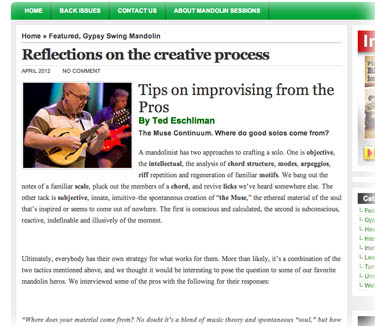
Further:
Compose yourself. Story Arcs
Compose yourself. Antecedent/Consequent thinking
Don Stiernberg on the "Big Picture" of improvising
Intentional Improvisation
More Appropriate
Posted by Ted at 7:10 AM
 May 22, 2014 | Best of JM: Vamps. Creating energy with Diatonic triads.
May 22, 2014 | Best of JM: Vamps. Creating energy with Diatonic triads.
Enjoy the popular archive material below.
From August 23, 2012 | Creating energy with Diatonic triads.
We've done several articles on 3-note chords, particularly 7th chords, including Major, Minor, and Dominant 7ths. It's long been our contention you don't need to worry about hitting all four pair of strings to get the most of your chords. Sometimes, not worrying about that 4th voice frees you up to move around the fretboard, plus liberate the pinky for all kinds of delicious mischief when you just voice comping chords on the thickest three strings.
But how about we go back a step further? There's nothing that says you always have to do 7ths or even extensions beyond that. Once in a while, a simple triad is enough, especially when you employ the tricks within this lesson. Triads (sans the 7th) based on the diatonic scale give you the same sense of motion and energy, without betraying the tonal center. Think of the song "Lean on Me." It's all a sequence of diatonic chords. I, I, ii, iii, IV... IV, iii, ii I, etc.
Lets start with simple triads based on the first three notes of an A scale:
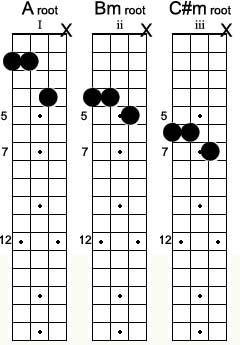
If you were playing a song with multiple measures of A chords, you could fill in with these, move up and down, back and forth:
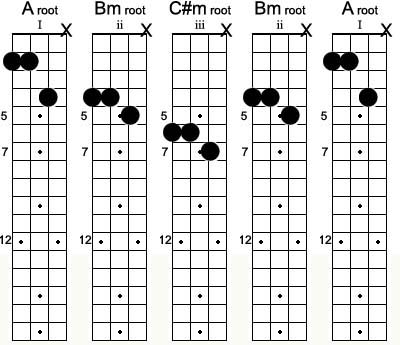
Many pit orchestra scores include simple instructions written: "Vamp." These will be measures where the conductor can adjust the length of the music to the dialogue, giving the actors more breathing room to articulate the dialogue. If a pianist or rhythm player were to just thump, straight A chords, the orchestration would be pretty dull. Chances are chords would be spiced up similarly and in a way that doesn't lose the sense of "A-ness" so that the singers and orchestra could return to the music. Of course, you can do the same in jazz comping.
Let's open it further by adding the IV chord. Move it up and down, mixing different chords in sequence:
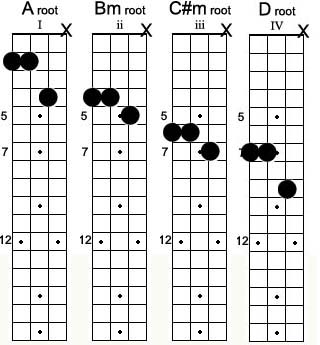
Next, let's broaden this by using a different inversion of the A chord . We spelled the earlier ones based on the root, aptly named "Root" position. Let's spell the chords with the 3rd (C#) as the lowest note (also known as 1st inversion, fellow theory geeks):
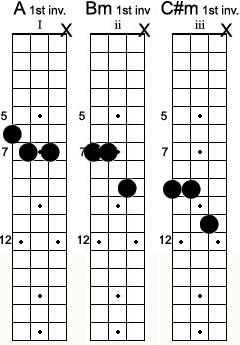
Add the IV chord, too:
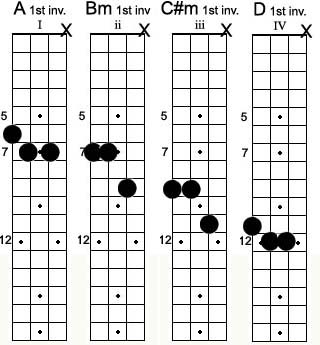
We still have one incarnation of the triad left to put as the lowest (bass) note, and we'll arbitrarily call this the 2nd inversion:
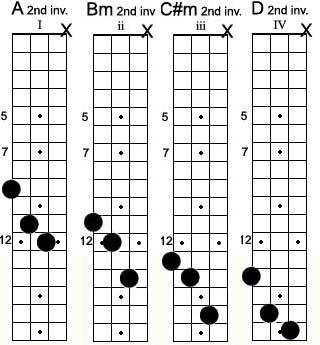
It gets up there in the fretboard stratosphere, but it's a good solid set of blocks for you to learn and internalize! Have fun moving these around. If this doesn't work on your mandolin as well, transpose the latter set to the key of D. We can do that, you know:
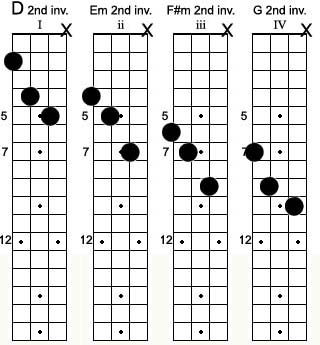
Note, you can run the board with this, literally. You can transpose the A root inversions to the key of D, and the 1st inversion as well. Step out and move these blocks into other keys and really have some fun. You'll see these repeat all over the place, and if you can internalize these 3-note blocks, you can open yourself up to untold possibilities!
1.) Chord melody. You have a free voice in the E string for voicing a melody
2.) Chord extension. Add a Maj7, Maj6, Add 9, etc
3.) Vamping texture. Make your chord comping interesting by inserting the variations into your background accompaniment.
Start practicing these in large and small doses. It will pay you back exponentially!
Further
Fitting in with triads
5-string chording. A different way of thinking...
Static Changes: V7 chords
More Three-note chords to supercharge your comping
Posted by Ted at 5:27 PM
 May 15, 2014 | More Reverse FFcP! Free Arpeggios PDF.
May 15, 2014 | More Reverse FFcP! Free Arpeggios PDF.
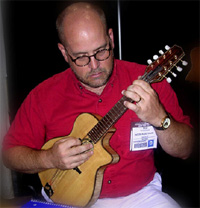
Last week, we mentioned the problem with always learning scales from the root up. We naturally think the scale from the bottom up, but never get very good about starting at the top and going the other way. It's like building strength in your right (or dominant) hand, and never bothering to develop muscles in the other. Just like you need both there, it's a good idea to be able to do your scales in reverse. We started the with the major (Ionian) FFcP exercise last week (see New FFcP... In reverse!).
This week we want to jump around. Literally.
One part of the basic FFcP is breaking a fairly common chord progression into arpeggios and getting that into your fingers. The classic 'I vi ii V7' set, the "doo wop" chords (or think the chords to the song "Heart and Soul") is a must-have in both harmonic and melodic vocabulary. We introduce this in basic bottom up version already, but now, it's top down time.
And all 12 keys!
Here you go:
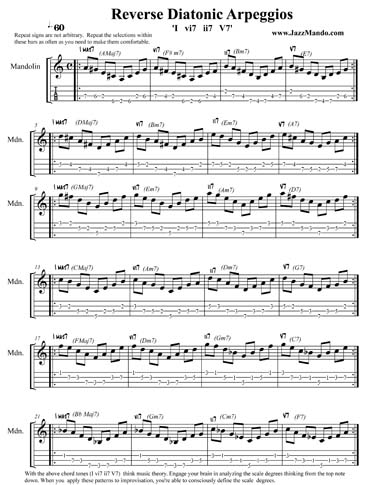
Download PDF
Further:
Spelling out the Chords. Melodically
New FFcP... In reverse!
Moving up the Fingerboard
Advanced FFcP
FFcP Introduction
Posted by Ted at 8:19 PM
 May 8, 2014 | New FFcP... In reverse!
May 8, 2014 | New FFcP... In reverse!
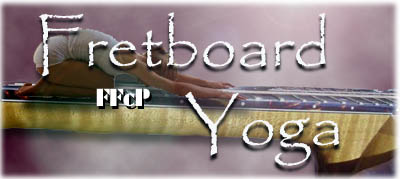
What goes up must come down.
We all learn scales from the note they are based on, the tonic. We lay them out in order, play them from bottom to top, and go about the discipline of driving them into our playing. Over and over, up and down, and almost always, bottom to top.
This is fine for learning them, but if we want to incorporate them into our soloing, we run the risk of making our improvisation sound like were just playing scales. In our FFcP system, we've already broken them up, using 3rds, 4ths, arpeggios, but there remains a weakness in always starting from the bottom. We need to free ourselves from always depending on starting from the tonic, and our latest installation of FFcP addresses this.
Introducing: Reverse FFcP!
We've taken the very first, the foundational major FFcP exercise and started from the top note of the scale. It sounds simplistic, but you probably struggle the first few times out of the gate trying it on your own so we've actually written it out in a 4 page PDF.
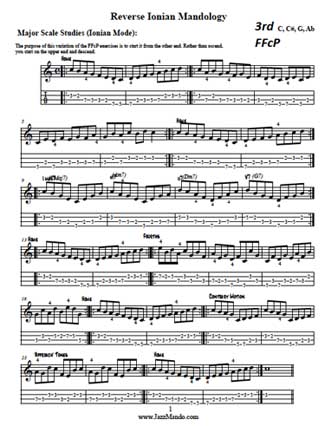
Download PDF
You're welcome.
We're not done. We intend to introduce more like this so feel free to give us feedback on what you think would be great to try for some melodic variety. Our next one will probably reverse arpeggios in all 12 keys.
Stay tuned...
Further
FFcP Introduction
Moving up the Fingerboard
Advanced FFcP
Pentatonic FFcP
Dorian/Minor FFcP
Augmented 11th FFcP
Posted by Ted at 8:23 PM
 May 1, 2014 | Taking Giant Steps; Improv secrets!
May 1, 2014 | Taking Giant Steps; Improv secrets!
We recently posted a couple cool videos of the classic bop tune, Giant Steps. The fast changing chords are both iconic and intimidating to the novice player, but even an intermediate one can learn some tricks to open up the song. The following masterclass video with pianist Mike Wolff can be an eye opener not only to this complex tunes, but ones with simpler harmonic vocabulary.

Even if your legs aren't long enough to take "giant steps," there are still some fantastic secrets to honing your own soloing vocabulary.
Video Link: Giant Steps Improvisational Concepts
Tune Basics; Understanding bigger picture, the pattern that repeats itself a 3rd down and a series of 'ii V7 I' Turnarounds.
Approaches to playing through the changes
1.) Playing arpeggios based on the chords and developing melodic ideas based on them. Sevenths, & just the simple triads
2.) Playing scales/modes based on key centers, B, G, and Eb. Up & down consecutive notes
3.) Playing Pentatonics, major and minor 5-note patterns. (Don't always start on the root!)
4.) Playing the "Big V" approach. Using scales (altered, diminished) based on the dominant of the key center and resolving on the tonic of the key center.
5.) Moving down by whole steps. Use scale & triads of key centers going down by consecutive steps.
6.) Chromaticism. Cheating by playing a string of consecutive chromatic notes.
Mix it all up!
Special bonus material: Guest writer Mark Wilson gives us a chord melody transcription of the head. Enjoy!
Mark Wilson: Giant Steps PDF

Click image for download
Further
Improvisation Techniques
Closing in on Bluesette
Raking it in. Autumn Leaves Pt. 2
A Path to Modal Improvising
More Appropriate
Posted by Ted at 10:37 AM

Disclaimer: In the 'Information Age' of the 21st Century,
any fool with a computer, a modem, and an idea can
become a self-professed 'expert." This site does not
come equipped with 'discernment.'
|



